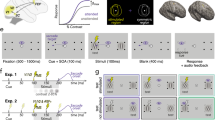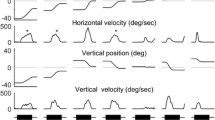Abstract.
To investigate the mechanisms of fixation disengagement and saccade initiation, we electrically stimulated the macaque frontal eye fields (FEF) while monkeys performed a visual fixation task. We tested the effect of introducing a temporal gap between fixation target offset and the onset of the electrical stimulus. We found that the duration of the gap had a pronounced effect on the probability of producing electrically evoked saccades at a given current level. The highest probability was found for gaps of 200 ms duration. There were also effects of gap duration on saccade latency and amplitude for most of the stimulation sites. The increase in saccade probability may be associated with lower current thresholds for evoking saccades.
Similar content being viewed by others
Author information
Authors and Affiliations
Additional information
Electronic Publication
Rights and permissions
About this article
Cite this article
Opris, I., Barborica, A. & Ferrera, V. On the gap effect for saccades evoked by electrical microstimulation of frontal eye fields in monkeys. Exp Brain Res 138, 1–7 (2001). https://doi.org/10.1007/s002210100686
Received:
Accepted:
Issue Date:
DOI: https://doi.org/10.1007/s002210100686




